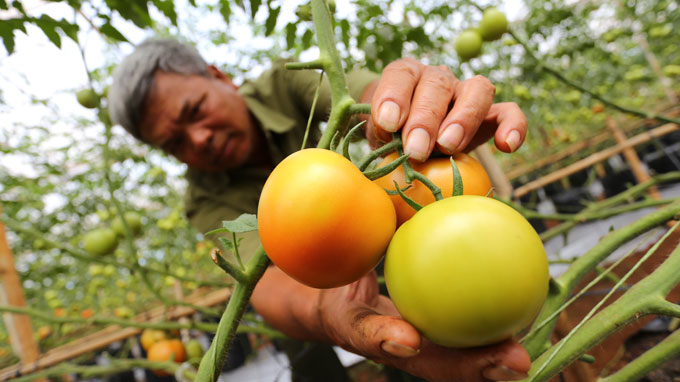Bigger is not always better, at least for several hi-tech vegetable growers in the Central Highlands city of Da Lat in Lam Dong Province.
By adapting modern cultivation technology, these farmers have successfully grown giant tomatoes, potatoes, and cabbage that are much larger than average sized vegetables.
But they are struggling to find buyers for their produce as most consumers associate abnormally large fruits and vegetables with China, not Da Lat, known nationwide for its fresh, clean, and safe vegetables.
Such a misconception stems from the fact that a wide variety of Chinese produce like ginger, garlic, cabbage, potatoes, and carrots is available in Vietnam in larger sizes than locally grown vegetables, while many cases regarding their poor quality and toxicity have been reported over the last few years.
“Many consumers insist that locally grown produce must be of normal size,” some traders said, describing how their giant fruits were rejected by customers.
Many vegetable distributors said they have also been forced to return the fruits and vegetables to the farmers after customers accused them of selling Chinese products.
The rejected vegetables are Beef tomatoes, originating from the Netherlands, which weigh around 0.5kg each; cabbage weighing 3kg each; and potatoes that weigh 1kg per 3 tubers.
Data from the Lam Dong agriculture department shows that there are around 30 hectares of crops in Da Lat and neighboring areas that grow this special produce.
Consumers’ suspicions have created a paradox for Da Lat produce: the giant products that are grown under standardized methods and modern technology are sold at lower prices than those that are immaturely harvested and of poorer quality.
Pham Thi Thu Cuc, a tomato grower in the province’s Lac Duong District, said the investment for one hectare of Beef tomatoes is five times more than for normal tomatoes, but she could only break even when selling to other places under the Da Lat brand name.
“I had to sell the high quality tomatoes at a cheap price, while those of lower quality, which account for only 20 percent of the total yield, sold for a lot more,” Cuc said.
Nguyen Cong Thua, general director of a vegetable growing cooperative in Da Lat, said he had to sell four tons of giant potatoes and cabbage at a loss after distributors returned them following the misconception by consumers that they were Chinese-grown.
Le Cong Thon, a farmer in Lam Dong’s Duc Trong District, had to adjust his modern technique so that it would produce smaller tomatoes to ensure sales in Da Lat, which will then be transported to other provinces and cities.
“I’d love to make bigger tomatoes but it is not simple because consumers are still unable to tell high-quality vegetables from Chinese produce,” Thon lamented.
Better promotion task
The solution to this paradox, according to experts, is that Da Lat high-tech produce growers must fortify the task of introducing their products to consumers countrywide so that they will no longer mistake them for Chinese fruits and vegetables.
“Growers should frequently launch programs to promote their products,” advised Nguyen Thi Cam Huyen, chief representative of Fresh Studio Dalat, a Dutch-owned hi-tech cultivation consultant firm.
“It’s a great pity that the Netherlands’ Beef tomatoes are mistaken for Chinese tomatoes,” she said, adding that this proves the promoting channel for Da Lat produce has not been effective.
The advice was supported by agriculture expert Le Huu Phan, who urged Da Lat farmers to take immediate action to get consumers across the country to learn of their high-quality produce.
“This should be done soon to prevent the reputation of Da Lat vegetables from being damaged,” Phan said.




















































